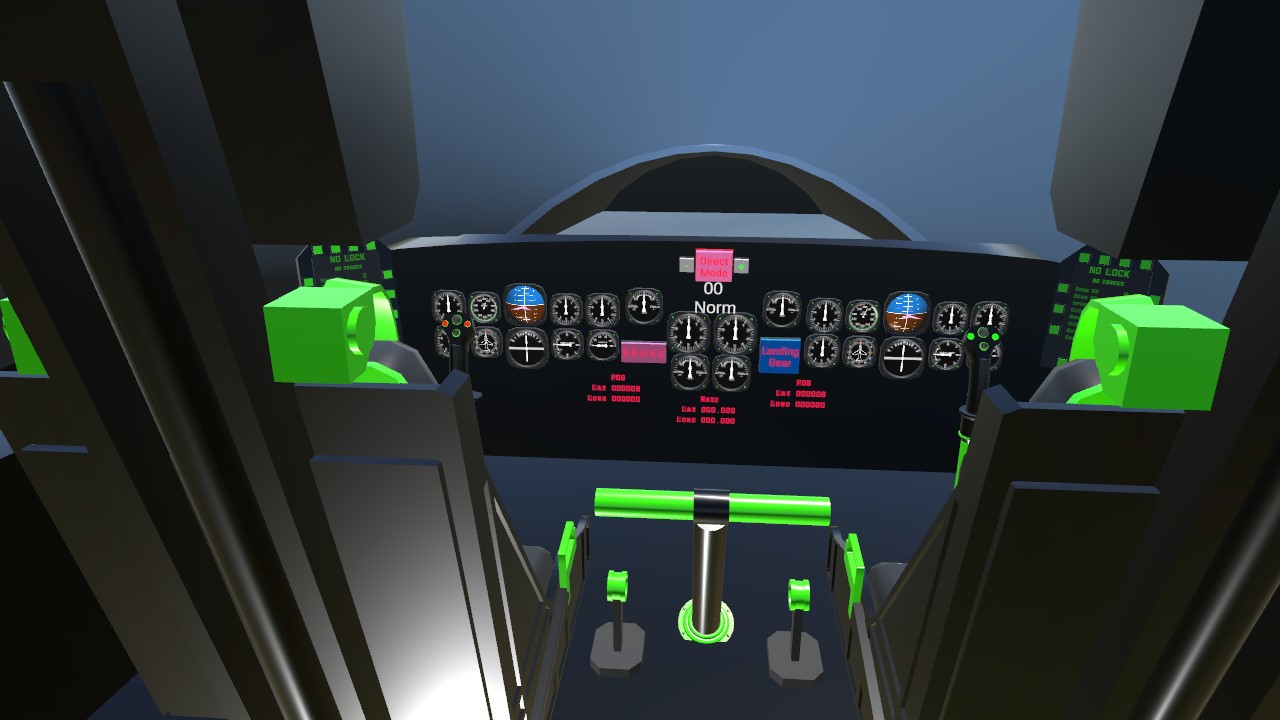This is my attempt at a transonic, fly-by-wire bomber, that can carry at least 12 Boom 50’s. It makes heavy use of the variable system.
How to fly:
AG 1: jettison lower bomb rack
AG 2: deploy parachute
AG 6: open the bomb bay
AG 7: control the flaps with trim
AG 8: nav lights
This plane has four control modes, numbered -2 to 1(because of how buttons light up), which can be selected by cycling with the buttons next to the ‘Direct Mode’ Button:
1: Direct mode, you control the control surfaces directly, but without full deflection available.
0: Normal mode, like Direct mode, but dampened by pitch rate and AoA, this is the default and recommended mode for normal flying.
-1: Alpha protection, you have a little bit of direct control, but your pitch and trim inputs mostly control the set value of a PD to achieve a particular AoA, this mode is recommended when you want to get the best performance out of this plane, like in steep turns and in terrain escape manoeuvres.
-2: Alternate Direct mode, you have full control of the control surfaces, this mode is a fallback mode, when the pitch mode variable is a value not assigned to a mode. You can do cobras in this mode, but I recommend switching to the Alpha protection mode with the + button, to recover to non-stalled flight.
Takeoff:
Brakes with the Brake button in the cockpit.
Flaps: ~50-75%
Throttle: 100%
Pitch mode: -1/Alpha protection
Release the brakes when the plane’s speed reaches ~3km/h / ~1mph
Pitch up max
Landing:
Brakes with the Brake button in the cockpit.
Flaps: 100%
Pitch mode: 0/Normal mode
Speed: ~300 km/h on approach
When heavy, use the parachute.
The remaining Boom 50’s are calculated independently of them being armed, which is done with interlocks to ensure you don’t blow yourself up, by launching a bomb into the bomb bay doors.
This plane was built with VR in mind, but since I don’t have SP VR and a VR headset, the geometry might not line up.
The gauges (left seat) from top left to bottom right in columns (top to bottom):
Angle of Attack: clockwise is nose up AoA
Angle of Slip: clockwise is nose right slip
Indicated Airspeed: in the white zone you must fly somewhat carefully
Heading: this incorporates a pointer to your current target (Option 7) and a ground track indicator (Option 1)
Attitude Ball: the pink arrow is your airplane
Bank Angle
Altimeter: in meters
Vertical speed: Option 2 shows 0-20 m/s with the numbers on the gauge matching up, Option 3 shows 0-100 m/s and Option 7 shows 0-200 m/s
Mach: unit per number on gauge Option 2: 0.01M, Option 3: 0.1M, Option 7: 1M
Throttle: Option 1: Throttle, Option 3: engine 1 percent of max thrust, Option 7: engine 2 percent of max thrust
Trim: Option 2: Trim, Option 3: Flap position
Engine 1 Thrust
Left Horizontal Stabiliser: Option 2: actual position, Option 3: commanded position
Engine 2 Thrust
Right Horizontal Stabiliser: Option 2: actual position, Option 3: commanded position
Specifications
General Characteristics
- Created On iOS
- Wingspan 85.7ft (26.1m)
- Length 108.5ft (33.1m)
- Height 24.5ft (7.5m)
- Empty Weight 58,691lbs (26,622kg)
- Loaded Weight 120,639lbs (54,721kg)
Performance
- Power/Weight Ratio 0.558
- Wing Loading 81.6lbs/ft2 (398.2kg/m2)
- Wing Area 1,479.0ft2 (137.4m2)
- Drag Points 8195
Parts
- Number of Parts 302
- Control Surfaces 32
- Performance Cost 1,960






